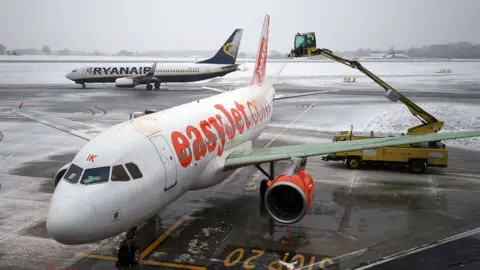 PA Media
PA MediaHeavy winds and fog led to thousands of flights being delayed or cancelled at the end of 2024 – and wintry weather could bring further disruption this weekend.
It can seem a mystery to many frustrated flyers that a brief spell of bad weather can upend schedules, especially since British weather isn’t exactly famed for being the best.
Many of us are used to facing train delays here in the UK – whether it’s leaves on the line or just a typical commute – but with all the technological advancements of planes and airports in recent years, why flights?
BBC News found out why there are many reasons poor weather can wreak havoc on passengers and crew alike.
‘Grim’ delay ordeal
Elif Arjin Celik was one of hundreds taken by surprise when her flight from London Gatwick to Istanbul was delayed by hours because of poor visibility in the fog on 28 December 2024.
With scores of flights at the airport delayed, during what was its busiest Christmas since the Covid pandemic, she saw thousands of people waiting in the terminal with nowhere to sit.
She says it was “grim” having to wait 20 minutes just to use the toilet because of queues from the “extreme overcrowding”.
 Elif Arjin Celik
Elif Arjin Celik“Fridges were empty with not enough food for everyone and all the restaurants were struggling to seat people,” she told the BBC.
That fog-related disruption ended up lasting for three days, affecting tens of thousands of Christmas travellers at airports across the UK.
So why exactly do so many flights get delayed in situations like this?
How efficiency can quickly turn to chaos
“Aircraft can operate safely in fog, but airports go into a kind of slow motion,” says travel expert Simon Calder.
“Aircraft follow a beam from the instrument landing system. This beam must not be broken, which could happen when it’s foggy,” he tells the BBC.
And when there are high winds, for safety, aircraft have to be more spaced apart than usual.
Despite Heathrow trialling artificial intelligence to help planes land in low visibility, controllers in on-ground towers still need to clearly see an aircraft arriving before issuing a landing clearance, aviation expert Scott Bateman MBE wrote on X.
He says the majority of modern aircraft can automatically land in the worst fog, but that in practice visibility limits are imposed so pilots can see sufficiently to taxi off the runway.
Mr Calder adds: “If fog or high winds requires air-traffic controllers to increase the spacing between aircraft by 50%, capacity is immediately reduced by one third – and cancellations begin.”
When things are running smoothly, Gatwick’s runway has a take-off or landing every 65 seconds. At Heathrow, schedules are based on landing aircraft as close as 80 seconds apart.
With this little room for error, Mr Calder estimates about 75,000 passengers were affected by the Christmas fog delays and cancellations.
And with upcoming warnings of snow, he advises passengers to brace for more disruption to their flights.
“The UK has seen some shocking snow closures, where big airports have simply not been able to cope,” he says, citing an incident in 2010 where hundreds of thousands of passengers saw cancellations at Heathrow because of snow.
Snow also caused Manchester Airport to close both its runways in December 2022 and again in January 2023, with flights diverted as far away as Dublin and Paris.
Although the extreme cost of disruption on this scale has led to British airports investing more in hardware and training to clear snow quicker, don’t expect us to cope like airports in the likes of Iceland and Greenland can.
Mr Calder says we might never be as good as other countries at keeping an efficient schedule in unusual weather.
“Historically the UK has had a benign climate. Spending millions preparing for an unlikely event has been hard to justify.”
Disruption could grow
And there’s not great news on the horizon because in the future, we can expect more disruption from weather related to climate change, says Dr Ella Gilbert, a climate expert from the British Antarctic Survey.
She says that climate warming increases the frequency and intensity of rain and snowfall events, making storms “stronger and more frequent.” It also means more instances of aircraft turbulence.
James and Madison King endured a lengthy diversion on their flight home to the UK from Stockholm at Christmas because of the fog.
They were within touching distance of home when their pilot announced they did not have enough fuel for a 50-minute holding pattern at London Gatwick, so they flew to Dublin to refuel and then back to where they started in Stockholm.
James says he still hasn’t received reimbursement for the incurred expenses of £200 for a hotel and dinner during this impromptu additional overnight stay in Stockholm.
 James King/ Madison King
James King/ Madison KingAt the centre of it all is Nats, the national air traffic service, which steps in to limit traffic in Britain’s skies during bad weather – forcing airlines to tear up schedules.
“Fundamentally, pilots don’t want to fly through storms,” Nats told the BBC.
During turbulence from storm clouds, passengers feel uncomfortable, and pilots will often want to leave their expected routes, ending up in unexpected parts of the sky, and at different times, the organisation explained.
“Because of this, we have to coordinate with the pilots to establish a new route in relation to any other aircraft they might be sharing the airspace with, as well as ensuring that any original traffic is separated from any unexpected additions.”
“If restrictions are lifted too early, they can risk an overpopulated airspace, while on the flip side, restrictions remaining in place longer than they need to can lead to unnecessary delays, which no one wants”.
It says it does have measures to mitigate the issues, including preventative Met Office weather equipment which can help airlines and airports avoid poor weather.
What are your rights if a flight is cancelled due to poor weather?
When flights are delayed or cancelled to or from a UK or EU airport, airlines have a duty to look after you, including:
- Providing meals and accommodation, if necessary, and getting you to your destination. The airline should organise putting you on an alternative flight, at no extra cost
- Your airline must let you choose between either getting a refund or being booked on to an alternative flight
- For short-haul flights, the threshold for compensation kicks in after a three hour delay – but is only payable if the delay is deemed within the airline’s control, meaning you won’t be entitled to it if your plane is held up by fog, a snow storm or security incident.

